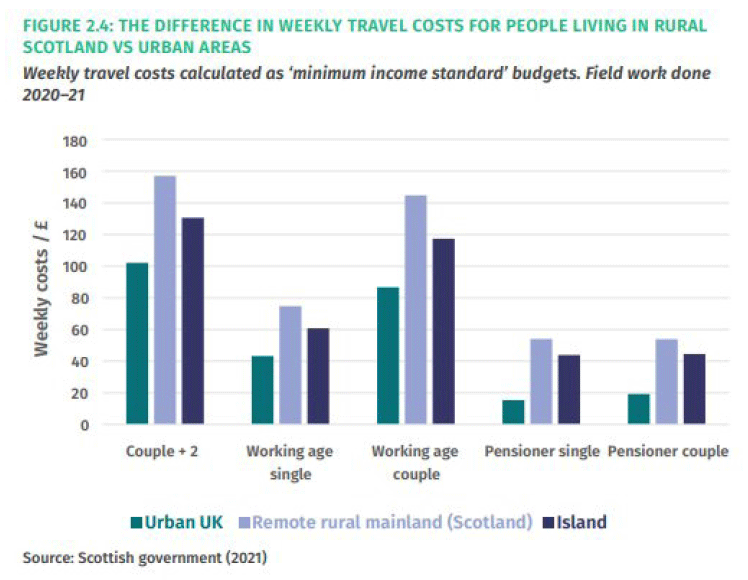Just Transition: draft plan for transport in Scotland
This draft plan identifies the key challenges and opportunities that the transport sector faces in making a just transition to net zero. We are seeking views as part of a public consultation, which will run until 19th May 2025.
Annex D: Communities and Places
A significant proportion of Scotland’s population live in urban areas; however, car reduction measures pose a risk of widening existing inequities in the transport system for rural communities. An appropriate redistributive strategy must outline how interventions will account for urban and regional differences to ensure small remote towns and remote rural communities are not unfairly burdened.
Car Use in Rural Areas
Evidence outlines the particular challenges faced by people living in rural and remote areas. For instance, households in rural areas were more likely to have access to a car than those in urban areas and they are more likely to have more than one car.[63] Car access in accessible rural households was 89%, compared to 64% in large urban areas, where more public transport is available.[64]
These trends are translated into transport spend. A higher proportion of income is spent on transport in rural areas.[65] The amount spent on car fuel is higher in rural areas, with around 50% of rural residents spend over £100 a month on fuel compared with 39% of people in the rest of Scotland. This suggests that affordability is likely to be a significant issue for people from low-income households in rural and island communities.[66]

In summary, car use and ownership are higher in rural areas as well as the amount spent on transport. Whilst Scottish Government has committed to reduce car use and tackle emissions, it is clear that where people live will have a bearing on their ability to reduce car use. This evidence underpins need for car use reduction measures to focus on urban areas and why incentivising the uptake of EVs, particularly in rural areas, will need to be part of our policy approach.
Engagement Quote Box: [from Ipsos Draft Report P61]: “I live in a rural area where the closest bus is a mile away and the closest train station is nearly 2 miles away. This means I’d have difficulty reaching either of those services, [and] when I am able to get there I’ve either had to walk or drive making it in my eyes a waste of time.” (Participant, phase 1, online community)
Access to Transport
There is a greater propensity for transport poverty in rural areas and fewer viable alternatives to cars which can result in ‘forced’ car ownership. Public Health Scotland define transport poverty as: the lack of transport options that are available, reliable, affordable, accessible or safe that allow people to meet their daily needs and achieve a reasonable quality of life.[67]
Transport poverty intersects with wider vulnerabilities, including fuel poverty. Those who experience transport poverty are more likely to experience other types of deprivation. This is more likely to occur in rural areas with transport poverty increasing the rural premium experienced, with the cost of goods and services being higher given the extra miles they typically travel.
Public transport accessibility to key services can be a particular challenge in remote rural areas. Rural Scotland Key Facts 2021 provides the following:[68]:
- Only 40% lived within a 15-minute public transport journey from the nearest GP (compared with 92% in non-rural Scotland).
- 63% lived within a 15-minute journey from the nearest Post Office (compared with 96% in non-rural Scotland).
- 29% within a 15-minute public transport journey to the nearest shopping facility (compared with 81% in non-rural Scotland).
We also know that satisfaction with public transport is lower in rural areas. Satisfaction rates for those living in remote rural and accessible rural areas (40% and 42% respectively) contrasted with a satisfaction rate of 68% for those living in large urban areas .[69] Limited viability of public transport routes has also led to the development of community-led and/or demand responsive transport solutions in some areas.
For island communities, ferries provide essential connectivity. Transport Scotland is aiming to publish the final versions of the Islands Connectivity Plan (ICP) Strategic Approach and the Vessels and Ports Plan in the coming months. This will include actions to enhance the ferry fleet’s resilience and reliability. More broadly, people in rural and island communities are more likely to experience climate-related disruptions to the transport network.[70]
Connectivity issues are not only limited to rural areas. We know that people in peri-urban areas may also experience poor public transport connectivity and the resulting impacts this has on economic, social and health outcomes.
Recognising that transport needs vary across our communities, we are committed to taking a place-based approach to car use reduction as part of a just transition. This aligns with our broader planning aims of The National Planning Framework 4 (NPF4), the vision, priorities and outcomes set out in our National Transport Strategy as well as commitments to living well locally and adoption of the Place Principle. Existing infrastructure will also support this. For example, Regional Transport Partnerships to strengthen the planning and delivery of transport developments, Community Planning Partnerships and the existing powers held by local authorities to support delivery of Local Transport Strategies.
Contact
Email: TJTP@gov.scot
There is a problem
Thanks for your feedback